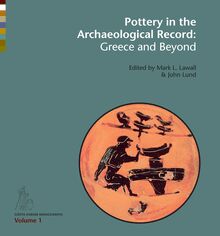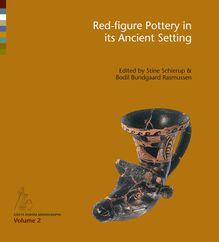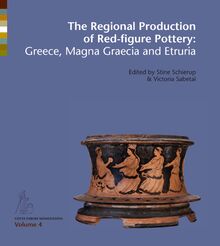-
 Univers
Univers
-
 Ebooks
Ebooks
-
 Livres audio
Livres audio
-
 Presse
Presse
-
 Podcasts
Podcasts
-
 BD
BD
-
 Documents
Documents
-
- Cours
- Révisions
- Ressources pédagogiques
- Sciences de l’éducation
- Manuels scolaires
- Langues
- Travaux de classe
- Annales de BEP
- Etudes supérieures
- Maternelle et primaire
- Fiches de lecture
- Orientation scolaire
- Méthodologie
- Corrigés de devoir
- Annales d’examens et concours
- Annales du bac
- Annales du brevet
- Rapports de stage
La lecture à portée de main
360 pages
English
Découvre YouScribe en t'inscrivant gratuitement
Je m'inscrisThe Regional Production of Red Figure Pottery , livre ebook
Découvre YouScribe en t'inscrivant gratuitement
Je m'inscris
Obtenez un accès à la bibliothèque pour le consulter en ligne
En savoir plus
En savoir plus
360 pages
English
Obtenez un accès à la bibliothèque pour le consulter en ligne
En savoir plus
En savoir plus

Description
In the latter part of the fifth century BC, regional red-figure productions were established outside Attica in regional Greece and in the western Mediterranean, propelled by the impact of the art of Attic vase painting. This collection of papers addresses key issues posed by these production centres. Why did they emerge? To what degree was their inception prompted by the emigration of Attic craftsmen in the context of the weakened Attic pottery market at the onset of the Peloponnesian War? How did Attic vase painting influence already existing traditions, and what was selected, adopted or adapted at the receiving end? Who was using red-figure in mainland Greece and Italy, and what were its particular functions in the local cultures? These and more questions are addressed here with the presentation not only of syntheses, but also primary publication of much newly discovered material. Regional production centres covered include those of Euboea, Boeotia, Corinth, Laconia, Macedonia, Ambracia, Lucania, Apulia, Sicily, Locri and Etruria.
Sujets
Informations
| Publié par | Aarhus University Press |
| Date de parution | 27 octobre 2014 |
| Nombre de lectures | 0 |
| EAN13 | 9788771243949 |
| Langue | English |
| Poids de l'ouvrage | 69 Mo |
Informations légales : prix de location à la page 0,2700€. Cette information est donnée uniquement à titre indicatif conformément à la législation en vigueur.
Extrait
The Regional Production of Redfigure Pottery:Greece, Magna Graecia and Etruria
Edited by Stine Schierup & Victoria Sabetai
Aarhus University Press
THE REGIONAL PRODUCTION OF REDFIGURE POTTERY: GREECE, MAGNA GRAECIA AND ETRURIA © Aarhus University Press and the authors 2014.
GÖSTA ENBOM MONOGRAPHS
General editor: Bodil Bundgaard Rasmussen.
Editorial board: Mark L. Lawall, John Lund, Dyfri Williams
Gösta Enbom Monographs is a peer reviewed series.
Published with support from The Foundation of Consul General Gösta Enbom.
Graphic design: Nina Grut, MDD.
Ebook production by Narayana Press.
Typeset with Stone Serif and Stone Sans.
ISBN978 87 7124 394 9 ISSN 19046219
Aarhus University Press Langelandsgade 177 DK8200 Aarhus N
White Cross Mills Lancaster LA1 4XS, England
70 Enterprise Drive, suite 2 Bristol, CT 06010, USA
www.unipress.dk
Front cover: Boeotian redfigure pyxis. Athens, Moutoussi collection (Photo: I. Miari. Photo courtesy: Hellenic Ministry of Culture and Sports/ Archaeological Receipts Fund).
Amphora attributed to the painter Syriskos, Athens 500 470 BC, Collection of Classical and Near Eastern Antiquities, The National Museum of Denmark, i.n. Chr. VIII 320.
Weblinks were active when the book was printed. They may no longer be active.
Table of Contents
5Per Kristian Madsen Preface
7Victoria Sabetai & Stine Schierup Introduction
13Victoria Sabetai Sacrifice, Athletics, Departures and the Dionysiac Thiasos in the Boeotian City of Images
39Kyriaki Kalliga A New Redfigure Kantharos by the Argos Painter: Contextual Study of the Pottery from the Grave of a Young Aristocrat at Haliartos, Boeotia
67Alexandra Zampiti Redfigure and its Relationship to the Blackfigure Technique in Late Classical Boeotia: The Case of the Boeotian Kalathospyxis and the Bilingual Vases
81Christina Avronidaki An Assortment of Bridal Images on a Boeotian Redfigure Pyxis from the Workshop of the Painter of the Great Athenian Kantharos
103Ian McPhee Corinthian Redfigure Pottery: A Brief Survey
121Kristine Gex Redfigure and Whiteground Pottery from Euboean Workshops
137Jutta Stroszeck Laconian Redfigure Pottery: Local Production and Use
157Anthi Aggeli Redfigure Pottery of Ambracia in Northwestern Greece
177Nikos Akamatis Local Redfigure Pottery from the Macedonian Kingdom: The Pella Workshop
191
217
235
247
269
279
291
303
311
315
355
Stine Schierup Patterns of Use in Early Metapontine Redfigure Pottery: Distribution, Shapes and Iconography
E. G. D. Robinson The Early Phases of Apulian Redfigure
Sebastiano Barresi Sicilian Redfigure Vasepainting: The Beginning, the End
Marco Serino The Beginnings of Sicilian Redfigured Pottery and its Relationship with Early South Italian Productions: A Reappraisal Through the Casestudy of the Himera Painter Workshop
Claude Pouzadoux & Pierre Rouillard From Imported Attic Vases to the First Regional Productions in Sicily: The Example of Megara Hyblaea in the Fifth and Fourth Centuries
Diego Elia Local Production of Redfigure Pottery at Locri Epizephyrii: A Synthesis on the Last Decade of Studies
Maurizio Harari – with an appendix by Mariachiara Franceschini Out of the Tondo: The Exterior of the Clusium Cups. An Iconographical Reconsideration
Lisa C. Pieraccini & Mario A. Del Chiaro Greek in Subject Matter, Etruscan by Design: Alcestis and Admetus on an Etruscan Redfigure Krater
Bibliographic abbreviations
Bibliography
List of Authors
Preface
B Y P E R K R I S T I A N M A D S E N D I R E C T O R G E N E R A L T H E N A T I O N A L M U S E U M O F D E N M A R K M E M B E R O F T H E B O A R D O F T H E F O U N D A T I O N O F C O N S U L G E N E R A L G Ö S T A E N B O M
Strolling through the Collection of Classical and Near Eastern Antiquities in the National Museum of Denmark, visitors are confronted with some of the very best examples of redfigure pottery produced in Athens during the Classical period, clearly demonstrating the high quality attained by Attic vase painting. Elsewhere in the exhibition visitors will be presented with redfigure pottery manufactured in other parts of the ancient world – so called regional productions – that leave an entirely different impression. Numerous examples of redfigure pottery from Magna Graecia are for example assembled in a single, large showcase in order to show the variety of styles and shapes. Our museum guests may easily gain the impression of a mass production of sorts. But is this a fair assessment? Attic redfigure vase painting occupies a prime position in scholarly research, compared with that of the regional schools. It has long been recognised that the redfigure technique was an excellent medium for Athenian potters and painters. Moreover, it teaches us a great deal about the society of ancient Athens. The pottery produced in regional centres – on the Italic peninsula as well as in Greece beyond Attica – has not hitherto been the focus of similar research. However, it is increasingly being realised that the conditions under which these operated differed, not only from those in Athens, but also from one region to the next. Furthermore, their study can expand our understanding of the cultural characteristics specific to these individual regions, their preferences for certain iconographic themes and the movement of artisans. This is the first monograph devoted to the regional redfigure production centres in both Greece and Italy and it seeks to clarify how these specific markets were affected by the transfer of a ceramic technique. The contributions reflect a trend away from merely identifying vase painters towards an endeavour to increase our understanding of pottery in its cultural context of use. They do this by
Consul General Gösta Enbom (18951986).
investigating the transformation of Attic vessel shapes and iconographic themes in the production centres of regional Greece, southern Italy and Etruria. The volume was conceived of within the framework of the research programme: ‘Pots, Potters and Society in Ancient Greece’, launched by the Danish National Museum in 2008 thanks to a substantial grant from the Foundation of Consul General Gösta Enbom. Further impetus was provided by the collaborative network established during the Enbom Workshop, 'Redfigure Pottery in its Ancient Setting', held at the National Museum of Denmark in 2009 and subsequently published in theGösta Enbom Monographs Seriesvolume 2. My most cordial thanks go to the contributors to the present volume and indeed to all other individuals who made this work possible, in particular the anonymous reviewers and the editors. A special debt of thanks is due to the Foundation of Consul General Gösta Enbom for supporting this publication, as well as the subsequent colloquium to be held in Athens in October 2014.
This page is protected bycopyright and maynot be redistributed.
P R E F A C E
5
Introduction
B Y V I C T O R I A S A B E T A I A N D S T I N E S C H I E R U P
During the latter part of the fifth century, new local redfigure fabrics were established outside Attica both in regional Greece and in the western Mediterranean, propelled by the success of the art of Attic vasepainting. Significant developments have been made in recent decades within this field, including reconsiderations of wellknown published material, iconographical studies, and new discoveries from controlled excavations which have broadened and sometimes significantly changed our perspective on these production centres. The Regional Production of Redfigure Pottery: Greece, Magna Graecia and Etruriatherefore brings together for the first time a comprehensive group of essays covering both the Greek and the Italic peninsulas in order to shed new light on important questions regarding local redfigure fabrics. Among the central questions addressed here are why these productions emerged c. 440 BC in the earliest cases (such as Lucania and Boeotia), and to what degree their inception was due to the emigration of Attic craftsmen in the context of the weakened Attic pottery market at the 1 onset of the Peloponnesian War. What was the influence of Attic vasepainting on already existing ceramic traditions, and what was selected, adopted and adapted at the receiving end? And who used redfigure in mainland Greece and Italy, and what particular functions did it perform in the local cultures? The articles published here provide both syntheses and primary publication of new material on the various regional styles of mainland Greek redfigure pottery. The overview chapters concern those fabrics that have been known for some time and have a good publication record, namely Corinth, Euboea and Laconia. Such syntheses allow us to ponder thestatus questionis, trace the gaps in our knowledge, and consider approaches, methods of study and future directions. Several of the essays present important new material for the first time in an excavation context (on the Boeotian, Ambracian, Laconian and Macedonian fabrics), while others publish hitherto unknown pieces from Boeotia and Euboea. Some papers – those on Boeotia, Corinth, Euboea and Macedonia – are underpinned by a
I N T R O D U C T I O N
comparative perspective, considering both the local red figure and the record of Attic imports. In other essays – some, again, on Boeotia – a particular regional aspect is presented so as to account for local redfigure within the context of the traditional pottery industry of late black figure. The volume’s first four articles discuss various aspects of Boeotian redfigure, contextualising it in terms of findspot, social use, pottery industry and artistic repertoire. The first article publishes three Atticising kraters from a woman’s grave depicting a scene of sacrifice, an athletic and a Dionysiac scene. V. Sabetai proposes to treat these three scenes not in isolation, but as a group of images with visual unity that reflect key civic values of the classical era. Her study focuses on the function of redfigure imagery as a medium for visualising both sociopolitical ideals and elements of identity in celebrations of life and death. Comparisons are drawn from the broad spectrum of earlier and contemporary Attic imports and Boeotian vases, and it is noted that redfigure was a rather rare commodity in Boeotia, deposited with deceased of special rank and/or age group. A similar situation regarding the rarity of redfigure and its deposition with particular classes of deceased is highlighted by a find from a cremation burial in a family precinct at Haliartos, Boeotia. K. Kalliga publishes the reconstructed ceramic assemblage from the wealthy and presumably aristocratic grave of a young man, an assemblage that, among several other grave goods, contained a bridle. The key piece of this ceramic group is a sole redfigure kantharos by the Argos Painter, with a so far unique (for this painter) depiction of an ephebe and his horse. The kantharos figures prominently in the grave group, which consisted of a wealth of Haimoneian and blackglazed vessels. A correlation between imagery, gender and high social class may be surmised in the case of the deceased, whose burial may have been treated with the exceptional care pertaining to those who die prematurely. A phenomenon peculiar to Boeotia is the relationship between regional redfigure and the local blackfigure tradition. A. Zampiti studies this relationship through the case of a special local vessel type, the kalathospyxis, as
1 See the questions already posed by MacDonald 1981.
This page is protected bycopyright and maynot be redistributed.
7
T H E R E G I O N A L P R O D U C T I O N O F R E D F I G U R E P O T T E R Y : G R E E C E , M A G N A G R A E C I A A N D E T R U R I A
8
well as through the Boeotian bilingual vases. The kalathos pyxis had a long evolution from the archaic era to the fourth century and tended to be a favourite in blackfigure and floral ware. Redfigure variants are rare, however, presumably because the kalathospyxis was narrowly bound to its own longstanding blackfigure tradition. The contribution of this paper lies in the contextualisation of Boeotian redfigure production in the setting of the local pottery industry, which continued to produce variants of the outmoded, but longlived and everchanging, blackfigure technique even in the advanced latter part of the fifth century. Her study is supplemented by new material from a hitherto unknown cave sanctuary close to Levadheia, that of the Leibethrian Nymphs. A unique pyxis attributable to the workshop of a brilliant Boeotian craftsman, the Painter of the Great Athenian Kantharos, is discussed in terms of its charming imagery, vessel type and place in this artist’s corpus by C. Avronidaki. The pyxis’s main vignette represents female nuptiality as a game of marriageable maidens and a mature woman playing ball. The adolescent females are depicted playing as a chorus of dancers led by an elder. Framing the pyxis’s main theme are vignettes featuring other bridal subjects, such as playing the harp in the guise of a Muse in a rocky setting, selfmirroring, and bending over a louterion for the nuptial ablutions. The pyxis is a most welcome addition not only to the Boeotian corpus, but to Greek ceramic art in general. It highlights the impact of Attic bridal thematography of the classical era in the Boeotian cultural milieu, as well as the region’s adoption of marriage iconographic schemes and ideals through the medium of redfigure ceramic art. Euboea was exposed to a more direct Attic influence, as reflected in the adoption of a particular vessel type: the redfigure lekythos and its variants in white ground. Local lekythoi figured in these techniques occur also in Corinth, but not in Boeotia or elsewhere. K. Gex publishes new pieces by the Torch and Berne Painters, which she considers on good grounds to be Euboean, and describes the monumental Eretrian ‘Huge Lekythoi’ of funerary character. She goes on to compare the two different images we can infer of the two Euboeanpoleisof Eretria (the home of local imitations of lekythoi in the 430s) and Chalkis (which is associated with other types of redfigure vessels at the end of the fifth century). The small quantities of fourth century local redfigure deriving from the settlements are
important, for this ware is usually drinking equipment, which coexisted with imported mixingbowls for wine. The author investigates the identity of and connections between Attic and Euboean vasepainters, as well as the selection mechanisms dictating choice of imported and/ or locally produced vessel types. She also discusses issues of attribution, findspot and market, as well as the selectively limited shape repertory of the Euboean fabric. Corinth is another major local fabric with a rich publication record, and Attic influence is evident in its products. I. McPhee offers an insightful survey of the history of research in this area and discusses issues of technique, shapes, subject matter, style, findspot and function, as well as problems of chronology. The krater, the pelike and the skyphos are the favourite shapes here, while mythological subject matter is limited in favour of scenes devoted to the realm of the Corinthian male as an ephebe and citizen, much as in Boeotia. As in other local redfigure fabrics, the style of drawing is influenced by Attic of the last quarter of the fifth century, but also by Apulian of the first half of the fourth. The presence of local redfigure in Corinthian sanctuaries and for purposes of dedication contrasts with its rare occurrence in graves, a remarkable circumstance and a marked contrast with the norm elsewhere (other than in Laconia). While workshops situated in regions in the immediate vicinity of Attica, such as those of Boeotia, Euboea and Corinth, began producing in the third quarter of the fifth century, more distant areas first adopted redfigure shapes and decorative schemes in the last quarter of the fifth century, while their production peaked in the first half of the fourth century and even later. Laconian figured pottery is associated mainly with sanctuaries (as in Corinth) as well as settlements, and is characterised by drinking vessels, some of which are particular to this production centre, such as the plain or monumental kothons. J. Stroszeck comments on the special uses of Laconian redfigure vases with mythological scenes found in dedicated niches of houses on the border between Laconia and Kynouria. She elaborates on the significance of kraters with male imagery from the grave in the Athenian Kerameikos of Spartans who fell in 403 BC fighting Thrasyboulos, and sees the Laconian figured pottery as related to Spartan identity in shape and imagery. The Ambracian fabric, almost totally unknown to this day, displays Attic but also Sicilian and Campanian
This page is protected bycopyright and maynot be redistributed.
-
 Univers
Univers
-
 Ebooks
Ebooks
-
 Livres audio
Livres audio
-
 Presse
Presse
-
 Podcasts
Podcasts
-
 BD
BD
-
 Documents
Documents
-
Jeunesse
-
Littérature
-
Ressources professionnelles
-
Santé et bien-être
-
Savoirs
-
Education
-
Loisirs et hobbies
-
Art, musique et cinéma
-
Actualité et débat de société
-
Jeunesse
-
Littérature
-
Ressources professionnelles
-
Santé et bien-être
-
Savoirs
-
Education
-
Loisirs et hobbies
-
Art, musique et cinéma
-
Actualité et débat de société
-
Actualités
-
Lifestyle
-
Presse jeunesse
-
Presse professionnelle
-
Pratique
-
Presse sportive
-
Presse internationale
-
Culture & Médias
-
Action et Aventures
-
Science-fiction et Fantasy
-
Société
-
Jeunesse
-
Littérature
-
Ressources professionnelles
-
Santé et bien-être
-
Savoirs
-
Education
-
Loisirs et hobbies
-
Art, musique et cinéma
-
Actualité et débat de société
- Cours
- Révisions
- Ressources pédagogiques
- Sciences de l’éducation
- Manuels scolaires
- Langues
- Travaux de classe
- Annales de BEP
- Etudes supérieures
- Maternelle et primaire
- Fiches de lecture
- Orientation scolaire
- Méthodologie
- Corrigés de devoir
- Annales d’examens et concours
- Annales du bac
- Annales du brevet
- Rapports de stage
Signaler un problème
YouScribe
Le catalogue
Le service
© 2010-2024 YouScribe










